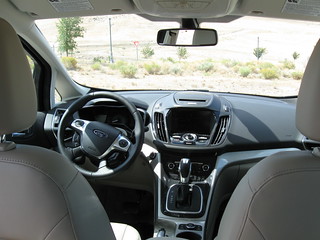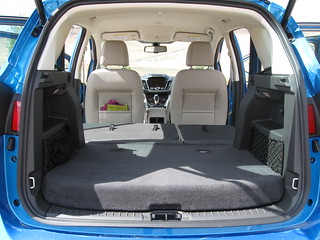New car, 2013 edition
 My friends, I have bought a new car.
My friends, I have bought a new car.
“Oh, it must be Saturday.”
Yeah yeah… (I would point out the last time I bought a car was nearly 5 years ago.) But the shocker is it’s not a Prius. It’s a 2013 Ford C-Max Hybrid. That’s right, after 12 years of Prius ownership, I have jumped ship. And I love it.
First, a little background. The C-Max is a competitor to the Prius v, not the regular Prius. When the 2012 Prius v was announced, I was confused about it specifically, and crossovers in general. It was advertised as a larger Prius, but my first impression was, “What’s the big deal? The numbers are a little larger, but it doesn’t look any bigger in photos. It can’t be much different.” After taking a test drive in a C-Max, I now get crossovers. The C-Max, like the Prius v (which I admit I haven’t been in) may have the outer stylings of a midsize hatchback, but the interior is laid out and feels a lot more like a compact SUV. Higher ride, more headroom, more room in general.
By the way, I categorize it as a crossover because frankly, the crossover category is already very loosely defined, and the C-Max doesn’t cleanly fall into an established category. Ford simply groups it as a “hybrid”, while Wikipedia calls it a “compact MPV” (a term not used in the US, though we would call a regular MPV a minivan) and groups it with light trucks. The EPA groups it as a “large car”.
So the C-Max looks like a hatchback on the outside, feels like an SUV on the inside, and handles like a Focus (which it is based on). I’ve been driving it since I bought it on Wednesday, and I love it.
(Let me point out that in my points below, I am comparing the 2013 Ford C-Max Hybrid to my previous second generation Toyota Prius. Not all points may be applicable to the current third generation Prius, or to the Prius v.)
First, I’ll get the bad points out of the way. It’s not a Prius. It won’t get the same fuel efficiency as a Prius. The EPA estimate is 47 MPG city/highway/combined, but at best, I’d describe that as a distortion of reality. At worst, I’d call it a downright lie. I have a feeling the C-Max was “taught to the test”; that is, it was designed to do best at the EPA standardized test. Real world usage will be about 38MPG, slightly lower than what my 5 year old Prius got in the real world.
The cargo area (before you fold down the fold-flat rear seats) is 24.5 cubic feet. My Prius was 14.4 cubic feet, but the floor surface area of the Prius was noticeably larger than the C-Max. So the C-Max technically has more cargo volume, but the Prius felt like there was more cargo room available. Also, the under-floor storage of the C-Max is greatly reduced compared to the Prius.
 That’s basically it for the cons. The C-Max shines at everything else I’ve found. The interior build quality is excellent compared to the Prius, and feels very solid. It’s noticeably quicker; 0-60 in 8.1 seconds, a full 2 seconds quicker than the Prius. Handling is much better as well.
That’s basically it for the cons. The C-Max shines at everything else I’ve found. The interior build quality is excellent compared to the Prius, and feels very solid. It’s noticeably quicker; 0-60 in 8.1 seconds, a full 2 seconds quicker than the Prius. Handling is much better as well.
The dash is beautiful. There are three LCDs, one each built into the left and right of the speedometer to display standard data (odometer, fuel remaining, etc) and hybrid data, and a large touchscreen LCD in the center dash. The default view to the left of the speedometer is “Coach” mode, which gives you bar graphs showing how efficient you are at acceleration, cruising and braking. To the right of the speedometer is “Efficiency Leaves”, which gives you an at-a-glance view of your efficiency. Careful driving will grow leaves on the branches, and wasteful driving will make the leaves fly off.
It also keeps track of regenerative braking. When you come to a full stop, it shows you the efficiency of that braking maneuver, with 100% meaning the brake pads were never used and all of the energy was recaptured to recharge the batteries. The main touchscreen also has a mode which shows what the ICE/electric systems are doing, like the Prius, but unlike the Prius, it tells you why the ICE has turned on (you’re accelerating rapidly, the batteries need to be topped off, etc).
The main functionality of the large touchscreen is a system called SYNC with MyFord Touch, and it’s great. The massive amount of functionality is a little unintuitive at first, but once you realize how things are laid out, it’s very easy to work with. GPS navigation looks decent, though I have not yet tried setting a route. It was easy to pair my iPhone with the car, and the built-in phone functionality works well. Climate control is more refined than on the Prius. But the best part is the entertainment system. It supports AM/FM, HD radio, CD, Sirius/XM, USB media, Bluetooth audio, and oddly, RCA A/V in (which I have not tested yet). The Bluetooth audio works great with the iPhone, song information displays on the LCD, and I have full control of playback/navigation from the touchscreen or the steering wheel.
Plenty of places for power too. One 12v lighter adapter inside the center console, one outside it, and one in the cargo area. And interestingly enough, the back seats have a standard NEMA receptacle, though it is limited to 150w (plenty of power for a laptop, though).
It supports automatic parallel parking as well, and to my surprise, it actually works! Press a button, and the car begins scanning the area as you drive. When you pass a spot long enough to work, it tells you when to stop, tells you to put it into reverse, and when you ease off the brake, it does everything else for you.
 Honestly, there are about a hundred other things I could mention, and I’m still finding new features. For example, today I found it has a WiFi client built into the car. Presumably for people who have garages, so it can use the internet connection in the house to download things like traffic/weather data. (My carpark parking space is too far away from my apartment for the car to see my access point.)
Honestly, there are about a hundred other things I could mention, and I’m still finding new features. For example, today I found it has a WiFi client built into the car. Presumably for people who have garages, so it can use the internet connection in the house to download things like traffic/weather data. (My carpark parking space is too far away from my apartment for the car to see my access point.)
The future of the C-Max in the US is uncertain. It’s been a badge in Europe for years (including non-hybrid models), but this is the first model year it’s been available in the US, as a hybrid only. J.D. Power ranked it last in initial quality, which is tracked by consumer complaints about design problems, and that was almost entirely due to two issues: the lower than expected MPG and the MyFord Touch system.
The MPG issue I already touched on; in my opinion it sucks that it’s advertised as 47 MPG, but I’m willing to accept that it won’t do more than 40 MPG in real-world usage. If they had advertised 40 MPG, I think it would have been a moot point for most people.
Apparently after the launch there were many, many problems with the usability of the MyFord Touch system. I’ve seen pictures from last year of it in action, and it even looked quite different than it does today. But they’ve released a handful of updates (the firmware is field-upgradeable), and I’ve had no problems with the version on my car.
I read a lot of reviews before I made the purchase, and while you would expect there to be a wide range of professional auto review opinions on a new car, they eerily all follow the same formula: Good looks on the outside, lots of space on the inside, excellent build quality, excellent power and handling for a hybrid, unrealistic MPG, and horrible entertainment interface. If everyone’s agreeing on the major points, and the two downsides are 1) acceptable to me and 2) already fixed through software updates, I consider that a good thing.
For the record, I’ve got the top trim level (C-Max Hybrid SEL) with the top package (303A), and includes every option but the sunroof. It was a bit expensive, $31,000, but I got a decent trade-in on my 5-year-old Prius, $14,000. Many of the options (such as nav, leather and MyFord Touch) are only available in the top packages, but for a semi-luxury car, it’s a pretty good price. There is also a plug-in hybrid variant of the C-Max, but as I don’t have a garage, it wouldn’t be useful (and it’s not approved for sale in Nevada yet).